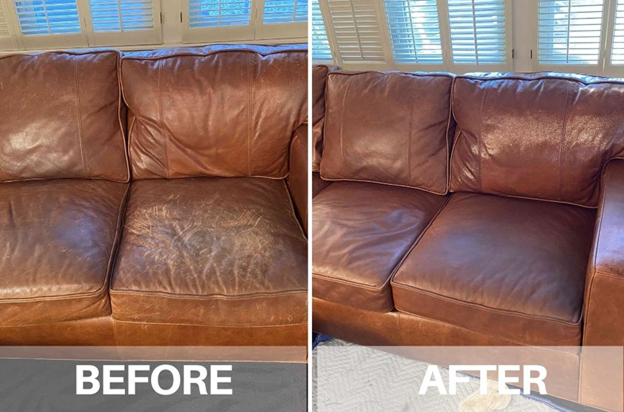
● 1. Vacuum the Leather Surface
- Remove Loose Dirt and Dust: Before using steam, it’s important to vacuum the leather to remove any loose dirt, dust, or debris. Use a vacuum with a soft brush attachment to avoid scratching the leather.
Focus on Seams and Crevices: Pay attention to seams, edges, and any cracks where dirt and dust tend to accumulate.
● 2. Pre-Spray with Leather Cleaning Chemical
- Before steaming, apply a leather cleaning chemical pre-spray to heavily soiled areas or areas with stains. This pre-spray helps break down grime, oils, and dirt, making the steam cleaning process more effective. Apply it evenly to the surface, paying special attention to high-traffic or heavily stained areas. Allow the solution to sit for a few minutes to loosen dirt and prepare the leather for steaming.
● 3. Prepare the Steam Cleaner
- Fill the Tank: Fill the steam cleaner with water (avoid using any chemicals unless specified by the manufacturer). Make sure the machine is set to low steam or moisture output, as too much water can damage the leather.
Set the Steamer to Low Heat: Set the steam cleaner to the lowest possible heat setting, as leather can dry out or get damaged if exposed to too much heat.
● 4. Steam Clean the Leather
- Hold the Steamer a Few Inches Away: Hold the steam cleaner nozzle at least 6-8 inches away from the leather surface to avoid direct contact and water saturation.
Use Short Steam Bursts: Move the steam cleaner nozzle across the leather in short bursts. Don’t allow steam to sit too long on any one area. The steam should be used to gently lift dirt and refresh the surface without soaking the leather.
Work in Sections: Clean the leather in small sections to ensure even treatment and avoid over-wetting the material.
Avoid Overheating: Ensure that the steam is never too hot, as excessive heat can dry out or crack the leather.
● 5. Wipe Off Excess Moisture
- Use a Microfiber Cloth: After applying steam to a section of leather, immediately wipe it down with a clean, soft microfiber cloth. This will help remove any excess moisture from the surface.
Gently Rub the Leather: Gently rub the leather with the cloth to spread the moisture evenly and prevent it from soaking into the leather.
● 6. Condition the Leather (Optional)
- Apply Leather Conditioner: Once the leather has cooled and dried slightly (it should be just damp, not wet), apply a leather conditioner or cream to restore moisture and flexibility to the leather. This will help prevent it from drying out and cracking.
Buff the Leather: After applying conditioner, use a clean, soft cloth to buff the leather and restore its shine.
● 7. Allow the Leather to Dry
- Air Dry the Leather: Allow the leather to dry naturally in a well-ventilated area. Avoid direct heat sources (like a hairdryer or sunlight) as they can cause the leather to shrink or crack.
Drying Time: Let the leather air dry for a few hours or until it feels dry to the touch. If you’re cleaning a leather couch or chair, you may want to let it sit for several hours to ensure it is thoroughly dry.
